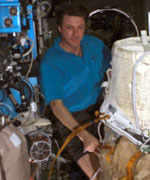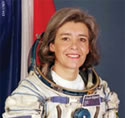Smoothly and ahead of schedule, Expedition 9 Commander Gennady Padalka and NASA Science Officer Mike Fincke completed the fourth and final spacewalk of their six-month mission today. Padalka and Fincke spent five hours, 21 minutes outside completing mainenance tasks and installing antennas to prepare for the initial arrival of a new European cargo ship next year.
Wearing Russian Orlan spacesuits, Padalka and Fincke began the spacewalk at 11:43 a.m. CDT, emerging from the Pirs airlock affixed to the Zvezda Service Module. It was Padalka?s sixth career spacewalk and the fourth for Fincke, all of his conducted during this expedition. The spacewalk was supervised by Russian flight controllers at the Mission Control Center in Korolev, outside Moscow.
After setting up tools and tethers, Padalka and Fincke quickly went to work. On the Zarya module, they replaced a pump control panel that measures the module’s coolant levels. They then installed a series of tether guides on four handrails. The guides are intended to prevent future spacewalkers? tethers from becoming snagged.
As the Station moved into orbital darkness, the spacewalkers took a rest break. During the break, flight controllers in Houston collected data on the orientation of the outpost. The information will help determine if the cooling systems of the Russian spacesuits contribute to changes in the Station?s orientation. Throughout today’s spacewalk, the Station remained in predicted orientations. No unanticipated measures were needed to maintain its stability.
Padalka and Fincke spent two and a half hours on the exterior of Zvezda, installing three communications antennas at its aft end. Those antennas, along with other equipment installed during an Aug. 3 spacewalk, will be used next year. They will guide the European Space Agency?s unpiloted Automated Transfer Vehicle (ATV), the “Jules Verne” cargo ship, to its maiden docking with the Station. Three more ATV navigation antennas will be installed by the next Station crew, Expedition 10, in February. The Expedition 11 crew will install ATV communications gear inside Zvezda as well.
Padalka and Fincke returned to Pirs and installed protective handrail covers at one of the two airlock hatches. The covers will ensure tethers do not inadvertently wrap around the handrails.
Fincke also photographed a suitcase-sized tray of Japanese commercial experiments mounted on Zvezda to measure the effect of micrometeoroids on a variety of materials. Called Micro-Particle Capturer and Space Environment Exposure Devices, they were installed on Zvezda almost three years ago.
With their work done, Padalka and Fincke returned to the airlock and closed the hatch at 5:04 p.m. CDT. The spacewalk was the 56th in support of Station assembly and maintenance and the 31st based from the Station. In all, Padalka and Fincke have spent 15 hours and 45 minutes outside the Station during their four spacewalks together. To date, spacewalkers have spent more than 338 hours outside the Station for maintenance and assembly work.
For information on the crew’s activities aboard the Space Station, future launch dates, as well as a list of opportunities to see the Station from anywhere on the Earth, visit:
For details on Station science operations provided by the Payload Operations Center at NASA’s Marshall Space Flight Center in Huntsville, Ala., visit:
Original Source: NASA News Release


